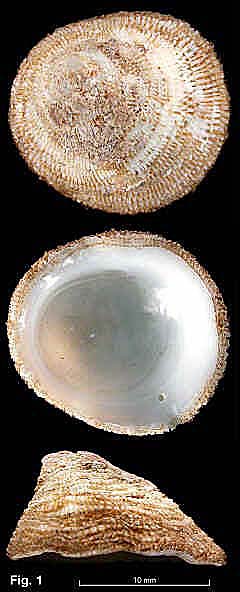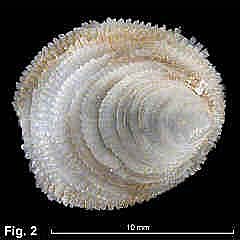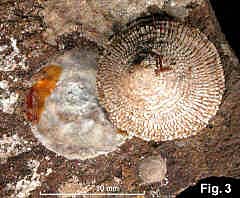|
|
|
|
|
Antisabia aff. foliacea (Quoy & Gaimard, 1835) Description: Shell solid, thick, limpet shaped. Apex position variable from almost central to overlapping posterior edge. Height variable, from about 35% to 70% of maximum diameter. Sculptured with 20-30 irregular concentric lamellae, each with radial grooves. Margin irregular, conforming to shape of substrate. Interior with ring of muscle scar parallel to margin, open at anterior end. Interior and exterior white, with brown periostracum when alive. Size: NSW specimens up to 18 mm diameter. Distribution: Known from the whole NSW coastline; probably distributed throughout southern Australia. See remarks below. Habitat: Lives attached to the substrate under stones at low tide level and below. Common in NSW. Synonymy: The NSW shell was known in early Australian literature as Antisabia antiquata (Linné, 1767), but that is an American species. Remarks: A shell of this description is common throughout southern Australia, and has been referred to as Antisabia foliacea (Quoy & Gaimard, 1835). But the type locality of that species is Guam, so it is probably not the correct name for the Australian species. A shell from South Australia was named Sabia erma Cotton. 1939, and it is likely that this is the correct name for the southern Australian mollusc. The name Antisabia foliacea has been used for animals that occur from east Africa to southern Japan, Hawaii, Tuamoto Archipelago, and Easter Island; and in Australia from Queensland around southern Australia to Western Australia. Knudsen (1993) suggested this is a species complex of three or four species. It is likely that in NSW a tropical member of the group occurs in the north of the state and a southern Australian species in the south. Knudsen (1993) made a detailed study of the Antisabia species he found at Rottnest Island, south-western WA; it may be the same species that occurs in southern NSW. It lives cemented to hard substrates intertidally, occurring as single individuals or small groups. After the larval shell settles the foot secretes a basal plate, cementing the animal to the substrate, where it remains fixed for the rest of its life (Fig. 3). It has a muscular, extensible proboscis, which it uses for foraging by grasping suspended organic detritus from the surrounding water. The female broods egg capsules in the mantle cavity, each containing 30-50 embroys; it is not known if these hatch out as crawling or free-swimming larvae. Fig. 1: Kurnell, Botany Bay, NSW (C.358407) Fig. 2: Wooli, NSW (C.358341) Fig. 3: La Perouse, Botany Bay, NSW (C.054573) |


